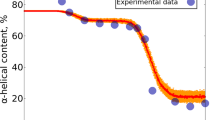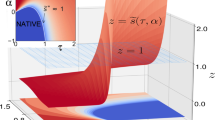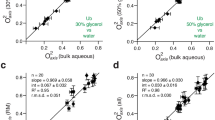Abstract
WE have naturally followed with much interest recent developments in the ‘cyclol’ hypothesis and the structure of the globular proteins1; but among other things we find difficulty in correlating the following two statements, presumably arrived at by applying the same theory to the same facts: (1) “The properties of proteins shown by our experiments seem to be in accord with the view that the protein monolayer is a two-dimensional network held together by strong elastic springs and are not in accord with a structure consisting of polypeptide chains” 2; (2) “This we interpret to mean that, in the formation of monolayers, some or all of the cyclol bonds are opened, few or none of the peptide links being broken, so that protein monolayers consist of polypeptide chains partially or wholly decyclized. This type of structure explains many of their striking characteristics: for example, viscosity, elasticity, etc.”3
Similar content being viewed by others
Article PDF
References
Wrinch, D. M., NATURE, 137, 411 (1936), et seq.; Wrinch, D. M., and Langmuir, I., J. Amer. Chem. Soc., 60, 2274 (1938); Langmuir, I., and Wrinch, D. M., NATURE, 142, 581 (1938): Bragg, W. L., NATURE, 143, 73 (1939); Bernal, J. D., NATURE, 148, 74 (1939); Robertson, J. M., NATURE, 143, 75 (1939).
Langmuir, I., Schaefer, V. J., and Wrinch, D. M., Science, 85, 76 (1937).
Langmuir, I., and Wrinch, D. M., NATURE, 143, 49 (1939).
Astbury, W. T., Bell, F. O., Gorter, E., and Van Ormondt, J., NATURE, 142, 33 (1938).
Author information
Authors and Affiliations
Rights and permissions
About this article
Cite this article
ASTBURY, W., BELL, F. Structure of Proteins. Nature 143, 280 (1939). https://doi.org/10.1038/143280a0
Issue Date:
DOI: https://doi.org/10.1038/143280a0
Comments
By submitting a comment you agree to abide by our Terms and Community Guidelines. If you find something abusive or that does not comply with our terms or guidelines please flag it as inappropriate.



